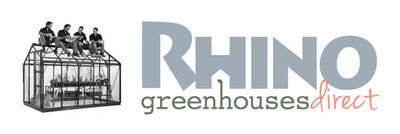Traditional Heating Methods & Eco-Friendly Alternatives
Baby, it’s cold outside – and the greenhouse is getting cold too.
No greenhouse can recreate the heat of spring or summer (without a significant amount of energy), so if you are hoping to grow tomatoes year-round, you may have to adjust your expectations. However, there is still plenty of gardening you can do and more than you could likely achieve without the aid of a greenhouse. Find out what you can grow during the autumn and winter months.
But no matter what you decide to do in your greenhouse, keeping frost out is going to be your biggest concern. So how do you do that? There are two main avenues: actively heating it up or insulating. Many people employ a combination of the two – after all, if you go to the expense of heating it, you will likely want to go to the effort of keeping the heat in!
TOP TIP 1: No matter what method you go for, remember that monitoring the temperature is going to be absolutely vital. So, invest in a good thermometer – or better yet, several!
Heating your greenhouse
Actively heating your greenhouse is the best way to keep growing a variety of plants throughout the year. It will never be as warm as a summer day, but you will certainly have greater growing opportunities than those with unheated greenhouses.
There are many clever ways to do this. If you have a background in construction or are a particularly keen DIY-er, then you can use your imagination. Some people install a wood burning stove (with a chimney-like addition) or run underfloor heating.
The easiest method, however, is to invest in a heater of some kind. Heated propagators and heated mats can also provide plenty of growing opportunities in every season and take away the need for heating the whole greenhouse.

Do’s and Don’ts for Using Greenhouse Heaters
The easiest way to heat your greenhouse is to get a greenhouse heater or heat lamp.
-
There are three popular kinds of space heaters: Gas (Paraffin or propane), oil or electric. Each has pros and cons.
- Gas and oil heaters do not require power supply, but will add moisture to the air, which can encourage mould and pests. They are also a greater fire hazard.
- Electric heaters are safest and create dry heat that will discourage fungal diseases, but have the downside of needing a mains power supply.
- Solar-powered alternatives are also on offer. These can be more eco-friendly, but aren’t always efficient, so do your research if you go for this option.
- Give it plenty of space. This will allow better circulation, prevent damage to plants and reduce risk of fire.
- Ventilate, regardless. Air circulation is key to spreading warmth through the greenhouse and ventilation will also prevent stagnant air. The plants still need to breathe and transpire, and it will reduce risk of mould etc.
- Invest in a heater with a Thermostat. This will mean better energy efficiency and less effort for you.
- Install a smoke alarm or carbon monoxide detector as necessary.
TOP TIP 2: Greenhouses with a partition can be used to create different climate conditions. Avoid heating the entire greenhouse by only heating the partitioned area.
Alternative methods to heat your greenhouse
Many people opt not to heat their greenhouses as it can be a costly endeavour and is unlikely to be environmentally friendly. Luckily, there are many ingenious ways to passively heat and insulate the greenhouse – you just have to be willing to get a little creative. Be thrifty and imaginative and you can be more eco-friendly.
TOP TIP 3: Start hoarding packing materials for repurposing in the greenhouse. Ask your friends and neighbours to the do the same; get friendly with your local shops and garden centres. They will have vast quantities of the good stuff you can re-use: bubble wrap, fleece and polystyrene make good insulators. Scrap construction materials like bricks and paving slabs can be useful for thermal mass too. Even recycled plastic bottles filled with water can become handy heatsinks.
-
Use bubble wrap to line the interior walls and wrap around containers.
- Dual-sided horticultural bubble wrap is better than the packing variety as it has much bigger bubbles, is stronger and offers UV protection. Bigger bubbles insulate better as well as letting in more light.
- Before hooking up to the inside of your greenhouse, clean the glass to maximise light transmission.
- Gently cover tender plants with fleece at night and during coldest periods. Remove the fleece on sunny days to give the plants additional light.
- Hang fleece from the eaves. Large greenhouses lose heat much faster, so hanging fleece from above will bring down the ceiling level, thereby reducing the area and making it easier to keep warm.
- Sit flowerpots on large blocks of polystyrene or in polystyrene boxes. Raising them off ground level will reduce frost risk and the polystyrene will retain warmth.
- Use Reflective materials to trap more light - Foiled Panels (Thermal Insulation Foil) and well-placed mirrors. Why not a Disco Ball?!
-
Create Micro-climates within the greenhouse
- Propagators
- Cold Frames
- Cloches
- Mini Greenhouse or Planthouse
- Even a clear plastic bag will do – just make sure there are holes to let the plants breathe

- Create heatsinks in the greenhouse. A heat sink can be bought or made. They can be complex works of engineering, or homemade contraptions from scrap materials. A heatsink can be as simple as a big bottle of water painted black, or a hole dug into the ground and filled with anything that acts as a good heat conductor: pea gravel, small pieces of metal, plastic bottles filled with water, bricks, etc. Thermal mass is the name of the game. Raised beds made from brick or metal within a greenhouse will also provide useful warmth.
- Composting inside the greenhouse. The decomposition process generates a lot of heat, so why not take the compost bin into the greenhouse for the winter?
Want to grow year-round in your own greenhouse?
A Rhino Greenhouse is the perfect environment for all your plants.
Updated - December 14, 2022
Published - October 29, 2020




